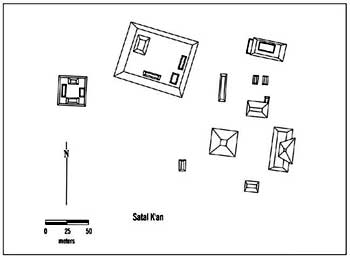
| FAMSI © 2003: Kathryn Reese-Taylor |
||
The Eastern Riverine Corridor During the Late Classic Period
Research Year: 1998 Table of Contents
Introduction The New River Lagoon Settlement Study was initiated in 1998 and completed in 1999, with funding from the Foundation for the Advancement of Mesoamerican Studies, Inc. (FAMSI) and the University of Wisconsin–La Crosse. The research area is located along the southern banks of the New River Lagoon, located in the Hill Bank sector of the Programme for Belize Reserve (PfB), a 260,000+ acre wildlife conservation area situated in northwestern Belize (Figure 1). The study area lies east of San José (Thompson 1939, 1966) and south of Lamanai, a major Maya city that was continuously occupied from the Preclassic through the historic periods (Pendergast 1977, 1981a, 1981b, 1981c, 1986). The region is important to our understanding of the development and decline in Maya polities because it links the settlements along the New River with major centres further east and, no doubt, was integral to coastal-inland trade. The escarpments to the northwest of the study area demarcate a boundary between the New River drainage basin and the Classic Maya states of the Petén. Exemplifying this border are the differences between the occupational history and ceramic inventory noted at La Milpa (Guderjan 1991; Grube and Hammond 1998; Hammond 1991; Hammond and Bobo 1994; Hammond and Tourtellot 1993; Hammond, et al. 1996; Tourtellot, et al. 1993; Tourtellot and Rose 1993; Tourtellot, et al. 1996; Tourtellot, et al. 1994) and Lamanai (Pendergast 1977, 1981a, 1981b, 1981c, 1986). In general, ceramic assemblages recovered from the New River drainage basin at Lamanai and nearby sites show more affiliation with those from the Belize Valley and northeastern Belize (Howard and Graham 1998; Powis 2001). 1 In contrast, ceramic assemblages located on the escarpment plateaus show a marked affiliation with ceramics from the Central Petén, especially during the Early Classic (Sullivan 2002). And both Graham (2002) and Sullivan (2002) have remarked upon the intra-regional integration seen in the ceramic assemblages of Lamanai and the Three Rivers Region, respectively, during the Late Classic. Further, Lamanai was occupied as early as 900 B.C. and continued, unabated, until the historic period (Pendergast 1981a). This contrasts with the later initial occupation of the uplands area at approximately 300 B.C. 2 In addition, the population in this region experiences the same dramatic decline that is evident throughout the central Petén at about A.D. 800. Given such a dramatic physical boundary between the two regions as well as the distinct occupational histories of the major centres in each, we hypothesized that the two areas may have been both socially and politically distinct. In other words, were these two regions organized in similar fashions or do we see evidence for socio-political variation? Recent research in northeastern Guatemala by the Río Azul Project and the Ixcanrio Archaeological project (Adams 1981, 1990, 1999; Adams, ed. 1986, 1987, 1989, 2000; Turner, et al. 1981), as well as research in the northwestern sector of Belize by the Three Rivers Archaeological Project (Adams and Valdez, ed. 1993, 1995; Dunning, et al. 1999; Durst 1996; Houk 1996; Kunen 2001; Lewis 1995; Lohse 2001; Manning 1997; O’Neal 1999; Robichaux 1995; Scarborough 1998; Scarborough, et al. 1995; Sullivan 1997, 2002; Tovar 1996; Valdez, ed. 1999; Walling, et al. 1995), the La Milpa archaeological project (Hammond 1991; Hammond and Bobo 1994; Hammond and Tourtellot 1993; Hammond, et al. 1996; Tourtellot, et al. 1993; Tourtellot and Rose 1993; Tourtellot, et al. 1994; Tourtellot, et al. 1996), the Blue Creek archaeological project (Grube, et al. 1995; Guderjan, ed. 1991; Guderjan and Driver, ed. 1995; Guderjan, et al., ed. 1996), and the Chan Chich archaeological project (Houk 1998a, 1998b; Valdez 1998) has produced a wealth of data on the socio-political organization of the northeastern Petén region. Further, this research has focused on both large centres and their interstices, giving us a well-rounded picture of the region. In addition, recent research at the long-lived centre of Lamanai has produced a clear picture of the significance of the city as the capital of a powerful kingdom that controlled trade along the New River throughout most of its history (Pendergast 1977, 1981a, 1981b, 1981c, 1986). However, few archaeological investigations have been conducted in the surrounding areas (Guderjan, et al., ed. 1996). Consequently, the main research focus of the New River Settlement Study was to examine the social and political organization of sites within the Lamanai sphere of influence. Further, did the socio-political organization of the southern New River drainage differ significantly from that seen in the Petén uplands? To address these questions, we formulated two research goals that could be completed within a single season: First, we would document the settlement in the region surrounding the southwestern margins of the New River Lagoon; and second, we would map the site of Satal K’an, a small center located approximately 5 km west of Hill Bank. Click to download the report in PDF format: The Eastern Riverine Corridor During the Late Classic Period (360 KB) The PDF files require Adobe Acrobat Reader.
Submitted 02/01/2003 by: |
||
| Return to top of page | ||
|
Text links to all pages at this site are available at the FAMSI INDEX |
||

